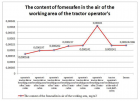Abstract
Research Article
Damu-Safen pesticide exposure risk assessment, EC (fomesafen, 250 g/l)
Aiman Nazhmetdinova*, Albina Izmailova, Altinay Chalginbayeva and Adlet Kassymbayev
Published: 11 January, 2019 | Volume 3 - Issue 1 | Pages: 001-010
Annually the list of pesticides is replenished by new ones. One of the main criteria for their registration is toxicological and hygienic assessment and its impact on the environment.
In order to register the new soy herbicide Damu - Safen, EC (fomesafen, 250 g/l) it was necessary to assess its toxicological and hygienic impact on the environment and humans. Therefore, for the first time we conducted studies of the environmental objects under the influence of Damu-Safen, EC (fomesafen, 250 g/l) and the risk assessment of the active substance fomesafen and pesticide Damu - Safen, EC on the workers. According to the results of the assessment of working conditions for the workers of the tanker and the tractor operator, an acceptable risk was obtained that meets regulatory and hygienic requirements. Residual amounts of fomesafen not exceeding the normative levels were found during conducted studies on environmental objects.
Consequently, the results of the risk assessment in the application of pesticide Damu-Safen, EC (fomesafen, 250 g/l) and its impact on the working people and environmental objects indicate the possibility of its application in compliance with optimal environmental conditions and compliance with regulations for appliances and personal protective equipment.
Read Full Article HTML DOI: 10.29328/journal.acee.1001012 Cite this Article Read Full Article PDF
Keywords:
Air; Soil; Water; Pollution; Fomesafen; Toxicological and hygienic assessment; Risk assessment; Environment
References
- Feng ZZ, Li QF, Zhang J, Zhang J, Huang X. et al. Microbial Degradation of fomesafen by a Newly Isolated Strain Pseudomonas zeshuii BY-1 and the Biochemical Degradation Pathway. J Agric Food Chem. 2012; 60: 7104–7110. Ref.: https://goo.gl/7CnHh9
- Onishchenko G, Bragina I, Potapov A. Estimation of the risk of exposure to pesticides on workers. l Methodical instructions. 2012; 1. 15.
- Belyakov AA, Melnikova LV. Development of methods for determining harmful substances on the skin. Gorky. 1984; 12.
- Potapov AI, Rakitsky VN, Bereznyak IV. Hygienic and analytical control over the exposure of the skin of people working with pesticides. Moscow. 2014; 8.
- Technical Regulations. Requirements for the safety of pesticides (toxic chemicals) No. 515 of 2008/29/05., Astana. 12.
- Klysenko MA. Methodical recommendations № 2365-81 “Guidelines for the determination of phenylurea herbicides (fenuron, koran, thimilon, monuron, diuron, dicuren, doxanex, tenor n, faloran, and rubber, if it is necessary, patran, maloran) in water, soil, plant material, vegetables and by definition herbicides (arezin, linuron, patoran, maloran) and their metabolites - aromatic amines - in water with the joint presence of gas-liquid chromatography. Moscow. 1991; 356.
- Khorram MS, Zheng Y, Lin D, Zhang Q, Fang H, et al. Dissipation of fomesafen in biochar-amended soil and its availability to corn (Zea mays L.) and earthworm (Eisenia fetida). Journal of Soils and Sediments. 2016; 16: 2439–2448. Ref.: https://goo.gl/XC9PzN
- Klysenko MA. Methodical recommendations No. 6218-91 “Guidelines for the measurement of chlorofluazuron (AME) concentrations in the air of the working area”. Moscow. 1991; 3639.
- Nazhmetdinova AS, Poshina SD. Methodical instructions for the determination of residual amounts of fomesafen in soybean, soybean oil and soil by high performance liquid chromatography
Figures:

Figure 1

Figure 2

Figure 3

Figure 4
Similar Articles
-
Wave Forces on Vertical Structures in Shallow Water: Numerical EvaluationFabio Dentale*,Ferdinando Reale,Angela Di Leo,Eugenio Pugliese Carratelli,Marina Monaco. Wave Forces on Vertical Structures in Shallow Water: Numerical Evaluation. . 2017 doi: 10.29328/journal.acee.1001003; 1: 020-033
-
Hydraulic jump experiment in a rectangular open channel flumeMostafa M El-Seddik*. Hydraulic jump experiment in a rectangular open channel flume. . 2017 doi: 10.29328/journal.acee.1001005; 1: 042-048
-
Natural and effective ways of purifying lake waterSavita Dixit*,Swapnil Lokhande. Natural and effective ways of purifying lake water. . 2017 doi: 10.29328/journal.acee.1001006; 1: 049-054
-
Rapid Microbial Growth in Reusable Drinking Water BottlesQishan Liu*,Hongjun Liu. Rapid Microbial Growth in Reusable Drinking Water Bottles. . 2017 doi: 10.29328/journal.acee.1001007; 1: 055-062
-
Cumulative Effect Assessment: preliminary evaluation for Environmental Impact Assessment procedure and for environmental damage estimationMarco Ostoich*,Andrea Wolf. Cumulative Effect Assessment: preliminary evaluation for Environmental Impact Assessment procedure and for environmental damage estimation. . 2017 doi: 10.29328/journal.acee.1001008; 1: 063-090
-
Use of Geosynthetic materials in solid waste landfill design: A review of geosynthetic related stability issuesMA Karim*,Lin Zhao. Use of Geosynthetic materials in solid waste landfill design: A review of geosynthetic related stability issues. . 2018 doi: 10.29328/journal.acee.1001010; 2: 006-015
-
Effect of cement solidification on strength and leaching properties of Heavy Metals Contaminated SoilSyed Taseer Abbas Jaffar*,Sajjad Yousefi Oderji,Si-an Zhang,Long-zhu Chen. Effect of cement solidification on strength and leaching properties of Heavy Metals Contaminated Soil. . 2018 doi: 10.29328/journal.acee.1001011; 2: 016-027
-
Damu-Safen pesticide exposure risk assessment, EC (fomesafen, 250 g/l)Aiman Nazhmetdinova*,Albina Izmailova,Altinay Chalginbayeva,Adlet Kassymbayev. Damu-Safen pesticide exposure risk assessment, EC (fomesafen, 250 g/l). . 2019 doi: 10.29328/journal.acee.1001012; 3: 001-010
-
The place of health innovation in space to improve the lives of earthlingsBrigitte Godard*. The place of health innovation in space to improve the lives of earthlings. . 2019 doi: 10.29328/journal.acee.1001017; 3: 045-053
-
A comparative study of solid waste management in the United States, Europe and AsiaMA Karim*,John Taylor Wetterhan. A comparative study of solid waste management in the United States, Europe and Asia. . 2020 doi: 10.29328/journal.acee.1001019; 4: 003-011
Recently Viewed
-
Investigation of Stain Patterns from Diverse Blood Samples on Various SurfacesSonia Rajkumari*. Investigation of Stain Patterns from Diverse Blood Samples on Various Surfaces. J Forensic Sci Res. 2024: doi: 10.29328/journal.jfsr.1001061; 8: 028034
-
The Impact of Forensic Science on the Legal System in IndiaSrishti*. The Impact of Forensic Science on the Legal System in India. J Forensic Sci Res. 2025: doi: 10.29328/journal.jfsr.1001072; 9: 001-006
-
Postural Stability Induced by Supervised Physical Training may improve also Oxygen Cost of Exercise and Walking Capacity in Post-Menopause, Obese WomenFernanda Velluzzi,Massimiliano Pau,Andrea Loviselli,Raffaele Milia,Daniela Lai,Daniele Concu,Gianmarco Angius,Abdallah Raweh,Andrea Fois,Alberto Concu*. Postural Stability Induced by Supervised Physical Training may improve also Oxygen Cost of Exercise and Walking Capacity in Post-Menopause, Obese Women. J Nov Physiother Rehabil. 2017: doi: 10.29328/journal.jnpr.1001001; 1: 001-011
-
Antibacterial Screening of Lippia origanoides Essential Oil on Gram-negative BacteriaRodrigo Marcelino Zacarias de Andrade, Bernardina de Paixão Santos, Roberson Matteus Fernandes Silva, Mateus Gonçalves Silva*, Igor de Sousa Oliveira, Sávio Benvindo Ferreira, Rafaelle Cavalcante Lira. Antibacterial Screening of Lippia origanoides Essential Oil on Gram-negative Bacteria. Arch Pharm Pharma Sci. 2024: doi: 10.29328/journal.apps.1001053; 8: 024-028.
-
Recovery of craniofacial proportions using the Nuvola Op System protocolAlessandro Carrafiello*. Recovery of craniofacial proportions using the Nuvola Op System protocol. J Oral Health Craniofac Sci. 2022: doi: 10.29328/journal.johcs.1001041; 7: 022-026
Most Viewed
-
Evaluation of Biostimulants Based on Recovered Protein Hydrolysates from Animal By-products as Plant Growth EnhancersH Pérez-Aguilar*, M Lacruz-Asaro, F Arán-Ais. Evaluation of Biostimulants Based on Recovered Protein Hydrolysates from Animal By-products as Plant Growth Enhancers. J Plant Sci Phytopathol. 2023 doi: 10.29328/journal.jpsp.1001104; 7: 042-047
-
Sinonasal Myxoma Extending into the Orbit in a 4-Year Old: A Case PresentationJulian A Purrinos*, Ramzi Younis. Sinonasal Myxoma Extending into the Orbit in a 4-Year Old: A Case Presentation. Arch Case Rep. 2024 doi: 10.29328/journal.acr.1001099; 8: 075-077
-
Feasibility study of magnetic sensing for detecting single-neuron action potentialsDenis Tonini,Kai Wu,Renata Saha,Jian-Ping Wang*. Feasibility study of magnetic sensing for detecting single-neuron action potentials. Ann Biomed Sci Eng. 2022 doi: 10.29328/journal.abse.1001018; 6: 019-029
-
Pediatric Dysgerminoma: Unveiling a Rare Ovarian TumorFaten Limaiem*, Khalil Saffar, Ahmed Halouani. Pediatric Dysgerminoma: Unveiling a Rare Ovarian Tumor. Arch Case Rep. 2024 doi: 10.29328/journal.acr.1001087; 8: 010-013
-
Physical activity can change the physiological and psychological circumstances during COVID-19 pandemic: A narrative reviewKhashayar Maroufi*. Physical activity can change the physiological and psychological circumstances during COVID-19 pandemic: A narrative review. J Sports Med Ther. 2021 doi: 10.29328/journal.jsmt.1001051; 6: 001-007

HSPI: We're glad you're here. Please click "create a new Query" if you are a new visitor to our website and need further information from us.
If you are already a member of our network and need to keep track of any developments regarding a question you have already submitted, click "take me to my Query."

















































































































































